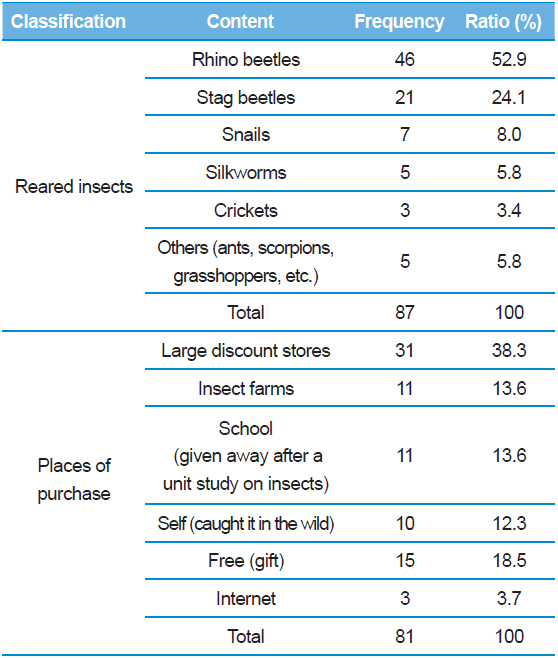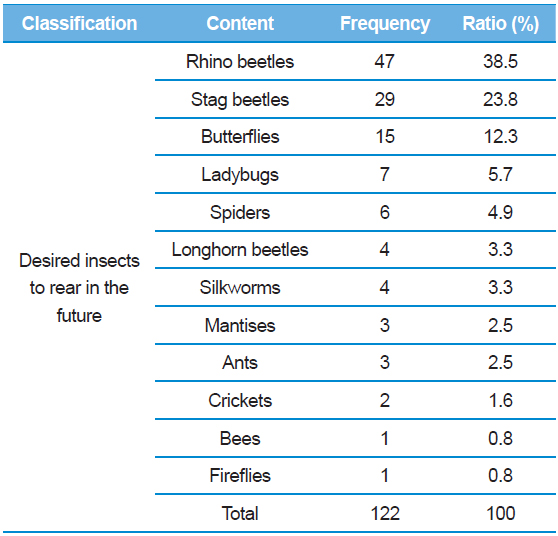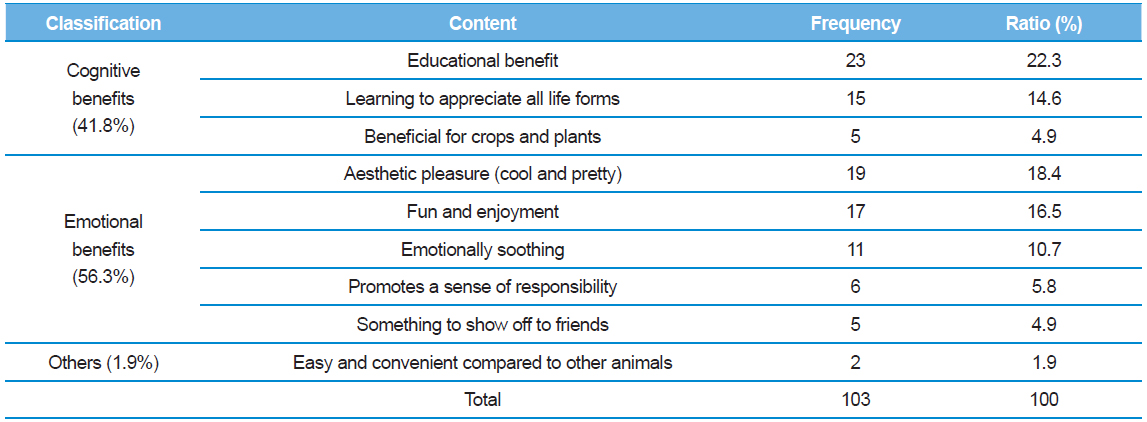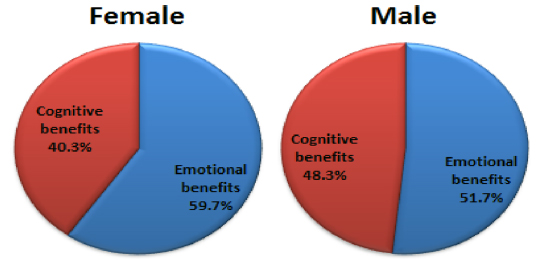



In an effort to obtain foundational data required to evaluate the therapeutic effect of educational insect rearing, this study surveyed current educational pet insect rearing practices in Korea and examined the expected psychological effects from participating in the activity. Data were collected from those who visited the special insect exhibition in May 2013 using a self-reporting survey. The results indicated that 48.3% of the responders had experienced insect rearing, and that rhino and stag beetles were the most commonly reared insects. Most of the respondents (83.1%) reported they were not currently rearing any insects, which suggested that insect rearing tends to be a one-time experience. Expected psychological effects could be divided into emotional (56.3%) and cognitive (41.8%) effects, and these varied by age and gender. The differences in expected psychological effects were particularly clear between adults and adolescents, the latter of whom were the main participants in the activity. It is therefore necessary to develop standardized manuals and care programs for more diverse insect species with which to help keep up consumer interest in educational insect rearing. These efforts will help champion the psychotherapeutic effects of educational pet insect rearing and enhance its role as a learning aid.
Throughout history, humans have cultivated a symbiotic relationship with animals and plants through hunting and gathering. Even after transitioning to an agrarian society, humans continued to cultivate such a relationship by domesticating wild animals and plants for companionship and aesthetic pleasure (Serpell, 2006). Many philosophers have emphasized the fact that small animals can help children develop empathy as well as a sense of responsibility (Fine, 2000). As for insects, children generally enjoy hunting insects and playing with them, as can be found mentioned in some traditional folk songs (Park, 2013). Insect rearing for companionship can be traced back in Korean history, although documented instances are rare.
The first of these can be found in Lee Gyu-Bo’s
Educational pet insect rearing was introduced in Korean elementary schools during the early 1990s and quickly started to spread. However, the emerging trend came to a halt owing to the ban on insect collection as a school vacation project. In July 1994, the Ministry of Environment requested that the Korean Federation of Teachers Association eliminate plant and insect collection from elementary summer vacation projects due to a sharp decrease in the insect population, and a nature conservation effort that was retracted as a result of teacher opposition. However, in July 1998, the Ministries of Education and Environment championed the “Environmentally conscious summer vacation” and banned plant and insect collection as summer vacation projects (The Kyunghyang Shinmun, 1999.4.17). The educational policy reduced schoolchildren’s insect collection activity, but the number of individuals who kept insects as pets started to increase. Commercial products for insect rearing first appeared in the media in 1992, with silkworms and ants being sold as pet insects (The Kyunghyang Shinmun, 1992.7.18). However, the trend began in earnest in the late 1990s, and the pet insect market developed rapidly, with insect rearing and sales of related products enjoying a steady growth trajectory in the early 2000s. Encouraged by the trend, 20 online and offline stores were opened, and by 2003, 8 portal sites became available, with about 50,000 site members distributed across them (Lee & Park, 2003).
Some of the most commonly reported reasons for keeping insects as pets are the insects’ splendid colors and appearances, their interesting behaviors, and their curious lifestyles (http://www. keepinginsects.com/introduction/history/). Pet insects can also include other arthropods that are taxonomic relatives to insects (Hemdal, 2007). In Korea, educational pet insect species include the insects that used to be commonly seen around the neighborhood (stag beetles, ants, silkworms, butterflies), large species with curious appearances (rhino beetles), and those that belong to other taxonomic groups, such as spiders and snails. Although these species are not technically insects, they are treated as such according to the “Act on fostering and supporting the insect industry.” The Listverse, which provides lists of rankings in diverse fields, recently reported stick insects, mantises, cockroaches, beetles, ants, centipedes, millipedes, hermit crabs, scorpions, and tarantulas as the Top 10 arthropod pets (Clark, 2012). Obviously, various other arthropods besides pure insects are kept as pets worldwide. Nevertheless, the most popular pet insects are still butterflies and beetles (http://www.keepinginsects.com/introduction/history/). Similarly, the steadily growing popularity of rhino and stag beetles has been the driving force behind the pet insect market boom in Korea.
In addition to being an educational tool for natural science and a personal hobby for many, pet insects are increasingly utilized for emotional therapy. However, the psychological effects of educational pet insects on caregivers have rarely been studied. In fact, only a single study by Kim et al (2013) is available, and it found that participatory educational pet insect rearing programs were effective in reducing stress among elementary schoolchildren.
The present study aimed to investigate current educational pet insect rearing practices in Korea and the potential psychological effects expected by the caregivers. Data were collected through a survey conducted on former, current, and future pet insect owners of all ages and genders. The results of the current study can contribute to quantifying the clinical effects of pet insect rearing on caregivers. Furthermore, the findings can be used as reference points to consider when addressing consumer demands for the pet insect market.
The study data were collected via self-reporting questionnaires distributed to visitors of a special National Academy of Agricultural Science insect exhibition held in May 2013 in celebration of Children’s Day. The survey was conducted between May 3rd and 5th of 2013 in the insect garden at the Agricultural Department of the National Academy of Agricultural Science located in Suwon, Gyeonggido. For sample extraction, a convenience sampling method, a type of non-probability method, was used.
The survey consisted of 13 questions, including: 5 on previous pet insect rearing experience, types of insect species reared, place of purchase and price, and current rearing status; 3 questions on the perceived benefits of pet insect rearing, insect species desired for future rearing, and the top 3 insect species that come to mind; and 3 questions on demographic characteristics. All questions were short answer and open-ended, except for those pertaining to the participants’ demographic characteristics. Survey participants ranged from kindergarteners to adults. The kindergarteners (6 and 7 year olds) who had experience in pet insect rearing provided the answers verbally, and these responses were recorded onto the questionnaires by their parents. For this reason, the kindergarteners’ data were excluded from the analysis of psychological effects pertaining to the cognitive and emotional benefits expected from pet insect rearing.
A total of 187 questionnaires were collected. Upon the elimination of 7 questionnaires that showed an inadequate level of response, 180 questionnaires were selected for analysis. For data analysis, Nvivo 8 (QSR International Pty Ltd), which is commonly used in qualitative study analyses, was used, as was the social science statistics program, SPSS (IBM, Ver.19.0).
In order to examine the participants’ demographic and general characteristics, a frequency analysis was performed regarding certain survey items, which included gender, age, and admission type (Table 1). The analysis found a higher proportion of female participants, at 73% (131 females) compared to their male counterparts (49), who supplied 27% of the responses. Age distribution ranged from kindergarteners to adults. Elementary schoolchildren accounted for the majority, at 33% (60 children), followed by adults in their 30s, at 18.4%. As for the admission type, families with children (149) accounted for 85% of the total, confirming that families with children in kindergarten and elementary school comprise the majority of those who are interested in rearing insects.
[Table 1.] General characteristics (N = 180)

General characteristics (N = 180)
Analysis of the questions pertaining to the participants’ pet insect rearing experiences found that a relatively high proportion of the survey participants (87 participants; 48.3%) had a previous pet insect rearing experience. The insect garden at the National Academy of Agricultural Science, where the survey took place, holds an annual special insect exhibition for Children’s Day. The program consists of various insect exhibitions, participatory activities, and insect giveaways, which include rhino beetles, stag beetles, and oriental garden crickets. Therefore, visitors participating in the program were expected to have a high level of interest in insects and previous experience of rearing insects.
Table 2 displays the details of the survey participants’ insect rearing experiences and the results of investigating the utilization potentials of pet insects. To analyze the details of insect rearing experiences, the survey participants were asked to list all the representative insect species they knew of, with no limits being placed on the number of answers. Of a total of 707 responses, butterflies and rhino beetles accounted for the majority, at 14.6% (103 responses) and 14.3% (101 responses), respectively, which confirmed the previous assumption. Most of the participants did not have sufficient knowledge of insect taxonomy. As such, general orders, such as “butterflies” were listed, for the most part with specific species, such as rhino beetles making an occasional appearance. In addition, the responses included 27 other insects, such as bees, stag beetles, ladybugs, dragonflies, crickets, ants, spiders, grasshoppers, and mantises. Although spiders and snails are not technically insects, they were included in the insect category for data analyses in consideration of their appearance.
[Table 2.] Participants’ insect rearing experiences

Participants’ insect rearing experiences
[Table 3.] Participants’ desired insects to rear in the future

Participants’ desired insects to rear in the future
As for the insect species which the participants had experience rearing, rhino and stag beetles together accounted for 77% of the total, at 52.9% (46 responses) and 24.1% (21 responses), respectively. In terms of the insect species the respondents desired to rear in the future, rhino beetles registered at 38.5% (47 responses), followed by stag beetles at 23.8% (29 responses), which together represented 62.3% of the total responses. In the case of butterflies, the level of recognition and knowledge among the public was high, thanks to “the life cycle of cabbage butterflies” segment featured in the 3rd grade textbook. Nevertheless, butterfly-rearing experience was extremely low amongst the survey participants, and butterflies lagged behind rhino and stag beetles for the insect species the respondents desired to rear in the future.
Next, the analysis of prices paid and places of purchase found that a significant proportion (38%) of the participants had purchased the insects at large discount stores in the neighborhood, while only 13.6% of the participants (11 responses) reported that the insects had come from farms or schools after a unit study on insects. Most of the participants with previous pet insect rearing experience appeared to have visited stores for the purpose of purchasing the insects or for purely observing them, which often resulted in igniting their desire to rear one. The average price paid per visit was KRW 10,909. Nevertheless, 83.1% of the survey participants (69 responses) with previous pet insect rearing experience reported that they were not currently rearing any pet insects, which suggests that insect rearing is mostly a one-time experience. In order to examine the psychological effects of insect rearing expected by the consumers, participants’ answers to the open-ended questions pertaining to the benefits of insect rearing were analyzed. Participants’ expectations for emotional benefits (55.3%) were higher than for cognitive benefits (41.8%). More specifically, “educational benefit,” “learning to appreciate all life forms,” and “a chance to closely observe nature” were cited as potential expected cognitive benefits. “Learning to appreciate all life forms” and “a chance to closely observe nature” represented a high proportion of the responses. In terms of the emotional benefits expected, “aesthetic pleasure (cool and pretty),” “fun and enjoyment,” and “emotionally soothing” were cited by the participants. Others benefits cited included “easy and convenient compared to other animals” (Table 4). An analysis was performed in order to examine whether expected psychological effects pertaining to cognitive and emotional benefits varied by the participants’ genders and ages. The results indicated that both male (51.7%) and female participants (59.7%) expected a higher level of emotional, rather than cognitive, benefits. However, this difference was not statistically significant. Additionally, male participants reported a higher level of expectation for cognitive benefits, whereas female participants reported a higher level of expectation for emotional benefits (Fig 1).
[Table 4.] Benefits of pet insect rearing

Benefits of pet insect rearing
To analyze the psychological expectations by age, survey data were grouped into kindergarteners, elementary school students, middle and high school students, and adults over the age of 20 years for a Chi-squared analysis. The results indicated that age differences exist in the distribution of psychological expectations, as shown in Table 5 (
[Table 5.] Chi-squared test ? cognitive/emotional benefits expected by age group

Chi-squared test ? cognitive/emotional benefits expected by age group
Insects and small arthropods (relatives of insects) are the perfect pets for people who live in small spaces, as they are quiet, pose little to no odor problem, do not require intense care, and can promote diversity of life (Hemdal, 2007). Looking at the global trend of pet insects in recent years, beetles and butterflies are still the mainstay of the market. However, the popularity of various large arthropods, such as large Myriopoda and tarantulas is on the rise. In Japan, beetles are popular. In 2002, 682,800 stag beetles (96 species) were imported as pet insects from 25 different countries. In 2004, 505 species of beetles were approved for import, and an 80-mm giant stag beetle was sold at the exorbitant price of JPY 10 million (Kawahara, 2007).
In Korea, on the other hand, rhino and stag beetles are the most commonly reared pet insect species, as the current study findings indicated. The trend appears to be following the pattern observed in the early days of the Japanese pet insect boom. However, unlike in Japan, foreign rhino beetles are not allowed to be imported as pet insects in Korea. As such, the market growth is capped at the current level of rhino and stag beetles. In the case of butterflies, although “the life cycle of cabbage butterflies” has been featured in school textbooks, butterfly rearing is still extremely rare. In fact, butterflies lagged behind rhino and stag beetles in terms of the insect species the respondents desired to rear in the future. It is therefore thought that rhino and stag beetles will remain the most preferred pet insects in Korea for a while.
The results of the caregivers’ expected psychological effects from insect rearing analysis indicated a clear difference between adolescent consumers (the majority of the consumers) and adult consumers (the main paying consumers). More specifically, adults had a high expectation for cognitive benefits, such as educational benefits and appreciation for all life forms gained while closely observing nature. On the other hand, adolescents, who are the actual consumers for all intents and purposes, showed a high level of expectation for emotional benefits, such as aesthetic pleasure, fun and enjoyment from insect rearing, and emotional soothing. Such results indicate why rhino and stag beetles are the preferred species on the domestic pet insect market. That is, rather than small and delicate butterflies (such as the cabbage butterflies), larger and seemingly more resilient species with a greater show-off value and greater potential personal reward can be more alluring. Therefore, it would be necessary to introduce new and larger beetle species onto the market to satiate adolescent consumers’ demands and expectations in an effort to stimulate the stagnant Korean educational pet insect market.
Most of the survey participants with previous experience in pet insect rearing reported having visited stores for the purpose of purchasing insects or for looking into the possibility of purchasing insects as pets. However, most rearing ended up as a one-time-only experience, a trend that is clearly in contrast with that of Japan, where there are 300 thousand beetle enthusiasts (Kawahara, 2007). Although the reasons behind such a short-lived experience are not addressed in this analysis, it is speculated that the failure to nurture simple curiosity into a sustained interest in insects, as well as failed experiences in raising mature insects play a big part. Unlike large companion animals like dogs and cats, insects do not offer deep emotional interactions with their caregivers. Nevertheless, they can offer a great deal of enjoyment and reward, as they grow well with a sufficient food supply and appropriate management methods according to the specific species, which usually result in successful metamorphosis. Such facts necessitate a continued effort to sustain consumers’ interest levels through active development and the distribution of standardized rearing manuals and caring programs.
Finally, the current study showed that pet insect rearing can be a beneficial tool for emotional therapy, as well as an effective educational tool, since the psychological effects expected from the activity vary by respondent age. Based on these findings, it is clear that the potential for developing programs that incorporate nature, such as forest therapy, horticulture therapy, and animal-assisted interventions, is significant.





